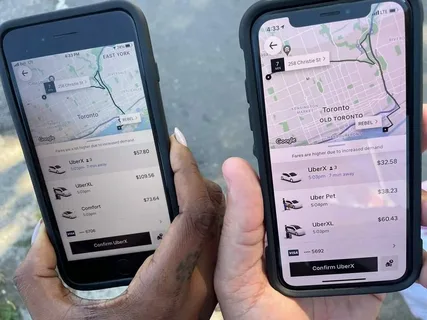The rise of ride-sharing apps has revolutionized how we move from one place to another, reducing dependency on traditional taxi services and offering more affordable, convenient travel options. But while short-distance rides have been the primary focus for most companies, the potential for long-distance ride sharing is becoming increasingly evident. Developing a long-distance ride sharing app presents unique challenges and opportunities, especially for developers looking to break new ground in the transportation industry.
In this article, we will discuss what it takes to develop a successful long-distance ride-sharing app, the necessary features, technology stacks, regulatory hurdles, and the crucial role of app developers in Chicago and other major tech hubs.
Table of Contents
ToggleUnderstanding the Need for a Long-Distance Ride Sharing App
Before diving into development specifics, it’s crucial to understand the demand for long-distance ride sharing. Commuters, travelers, and even those looking for a cost-effective alternative to buses and trains have shown an increasing interest in ride-sharing services that cater to journeys beyond city limits.
Key benefits include:
- Cost Efficiency: Long-distance ride-sharing reduces the cost of traveling between cities by allowing multiple passengers to split the fare.
- Convenience: It provides a more comfortable and personalized experience compared to public transport, with flexible pick-up and drop-off points.
- Environmental Impact: By carpooling, long-distance ride-sharing can contribute to reducing carbon emissions, as fewer individual cars are on the road.
Given these advantages, there’s no doubt that a well-developed long-distance ride-sharing app can address a growing market. But what exactly does it take to create one?
1. Market Research and Identifying Target Audience
Developing a successful long-distance ride-sharing app begins with thorough market research. It’s essential to:
- Identify Your Target Audience: While long-distance ride sharing has broad appeal, your app might cater to specific groups, such as commuters, business travelers, or tourists.
- Understand Competitors: Analyze existing players in the long-distance ride-sharing space. Apps like BlaBlaCar and Poparide have pioneered long-distance rides in certain regions. Understanding their strengths and weaknesses will help you craft a unique value proposition.
- Gauge Market Demand: Use surveys, focus groups, and public data to gauge how many people would be interested in using a long-distance ride-sharing app in your targeted area.
Successful market research will guide you through the development process, ensuring you create an app that meets real-world needs rather than speculative ones.
2. Choosing the Right App Development Team
One of the most critical factors in developing a successful app is choosing the right team of developers. Whether you’re in the heart of Silicon Valley or the Midwest, securing skilled and experienced developers is key to creating a high-performing app. This is where app developers in Chicago come in, especially since Chicago is a burgeoning tech hub with a thriving community of developers skilled in mobile and transportation apps.
Why Hire App Developers in Chicago?
- Strong Tech Talent Pool: Chicago is home to some of the best tech universities, leading to a highly skilled pool of developers proficient in the latest technologies.
- Experience with Transportation Apps: Many app developers Chicago have experience working on transportation, logistics, and mobility solutions, making them ideal candidates for a long-distance ride-sharing project.
- Cost-Effective Solutions: Compared to tech hubs like San Francisco or New York, Chicago offers more affordable development services while maintaining high-quality output.
When you work with a dedicated team, such as Chicago-based app developers, you benefit from their local expertise, tech insights, and understanding of transportation app needs, ensuring your long-distance ride sharing app meets industry standards.
3. Core Features of a Long-Distance Ride Sharing App
To create a successful long-distance ride-sharing app, you need to prioritize certain core features. These features must address both the drivers’ and passengers’ needs to ensure an enjoyable, safe, and efficient experience.
a) User-Friendly Interface
The interface must be intuitive and easy to navigate. Whether someone is using the app for the first time or is a regular user, the design should provide a seamless experience across all devices. Here’s what to consider:
- Simplified Registration Process: Offer multiple sign-in options (email, social media, etc.) to make the onboarding process smooth.
- Ride Search: Allow passengers to easily input their starting location, destination, and time to find available rides.
- Driver Availability: Enable drivers to set their availability, route preferences, and even share their driving history with passengers for trust-building.
b) GPS and Navigation Integration
A long-distance ride sharing app must include robust GPS and navigation tools. Accurate route mapping is crucial for long journeys, and this requires:
- Real-Time GPS Tracking: This ensures both drivers and passengers can see each other’s locations and route progress.
- Turn-by-Turn Navigation: Integrating reliable navigation like Google Maps or Apple Maps will make it easier for drivers to follow the optimal route.
- Geolocation Services: Accurate geolocation is vital for meeting points and tracking the exact routes of long-distance rides.
c) Ride Scheduling and Reservations
Given the nature of long-distance journeys, most passengers will plan ahead. Therefore, your app should offer a ride scheduling feature where users can book a ride days or even weeks in advance. This could include:
- Ride Pre-Booking: Allow passengers to book rides for future dates, and let drivers accept or decline those requests based on their schedules.
- Automated Reminders: Send notifications or reminders to users about upcoming rides, ensuring both passengers and drivers are prepared.
d) Payment Integration
Smooth, hassle-free payment integration is critical for your app’s success. Implement secure, reliable payment gateways that support multiple options, including credit/debit cards, digital wallets, and even in-app currencies or discounts. Consider:
- Fare Splitting: Enable multiple passengers to split the fare equally or based on distance traveled.
- Dynamic Pricing: Introduce dynamic pricing based on factors like demand, time of day, or driver availability to ensure fair compensation for drivers while offering passengers competitive rates.
e) Rating and Review System
Both passengers and drivers should be able to rate each other. This system helps to build trust, and it ensures accountability. Features to include are:
- Passenger Ratings: Allow drivers to rate passengers based on their behavior during the ride.
- Driver Ratings: Passengers should be able to rate the driver based on factors like punctuality, driving skill, and overall experience.
4. Advanced Features for Differentiation
While the core features will provide the foundation for your app, advanced features can help differentiate your long-distance ride-sharing app from competitors. Here are some ideas:
a) In-App Messaging
Allow passengers and drivers to communicate within the app without sharing personal phone numbers. This feature enhances privacy and makes coordination easier.
b) Carpooling and Group Rides
For long-distance rides, the ability to carpool with multiple passengers is crucial. The app can suggest potential passengers based on their proximity to the driver’s route. This can increase ride availability while lowering costs for all parties.
c) Environmental Impact Tracking
Appeal to eco-conscious users by providing metrics on how much carbon they’ve saved by carpooling. You could also introduce a feature that offsets carbon emissions through partner organizations.
d) Driver Incentives
Incentivize drivers with bonus payments for longer rides or frequent usage. A points-based system or gamification can help keep drivers engaged and ensure there’s a steady supply of drivers on the platform.
5. Technological Stack for Long-Distance Ride Sharing App Development
A ride-sharing app requires a robust tech stack to ensure smooth functionality, scalability, and security. Here’s a recommended tech stack for building a long-distance ride sharing app:
- Front-End Development: Use modern frameworks like React Native or Flutter for cross-platform app development, ensuring your app works seamlessly on both iOS and Android.
- Back-End Development: Opt for reliable back-end technologies like Node.js or Django for scalable server-side development.
- Database: Use a powerful and scalable database system like MongoDB or PostgreSQL for managing large volumes of user data and ride histories.
- GPS and Geolocation APIs: Integrate Google Maps API or Mapbox for accurate location tracking and navigation.
- Payment Gateway: Implement Stripe, PayPal, or Braintree for secure, seamless payment integration.
- Cloud Infrastructure: Use AWS or Google Cloud for cloud hosting and storage, ensuring your app can scale up as demand grows.
6. Regulatory Considerations
When building a long-distance ride sharing app, it’s important to account for legal and regulatory hurdles, particularly because long-distance rides may cross state or even country lines.
- Licensing and Permits: Ensure your app complies with local transportation laws, including driver licensing, vehicle inspections, and insurance requirements.
- Passenger Safety: Integrate safety features such as SOS buttons, background checks for drivers, and ride tracking to enhance passenger security.
- Insurance: Work with insurance providers to offer coverage for drivers and passengers during long-distance rides.
7. Marketing and User Acquisition
Once your app is built, getting it into the hands of users is the next big step. Consider a multi-channel marketing strategy that includes:
- Social Media Campaigns: Target both drivers and passengers via platforms like Facebook, Instagram, and LinkedIn.
- Referral Programs: Encourage users to refer friends and family in exchange for discounts or ride credits.
- Partnerships: Collaborate with travel companies, universities, or businesses to offer exclusive rides for their customers or employees.
8. Post-Launch Support and Updates
After launching your app, continuous support and updates will ensure its long-term success. Regularly introduce new features, fix bugs, and improve user experience based on feedback.
Conclusion
Developing a successful long-distance ride sharing app requires a strategic combination of market research, technical expertise, and user-focused features. By partnering with skilled app developers in Chicago or other major tech hubs, and incorporating essential features like ride scheduling, payment integration, and real-time GPS tracking, you can create an app that meets the growing demand for long-distance transportation solutions.
From selecting the right development team to integrating advanced functionalities, this guide outlines the essential steps to ensure your long-distance ride-sharing app not only stands out in the market but also becomes a go-to solution for commuters and travelers alike.




